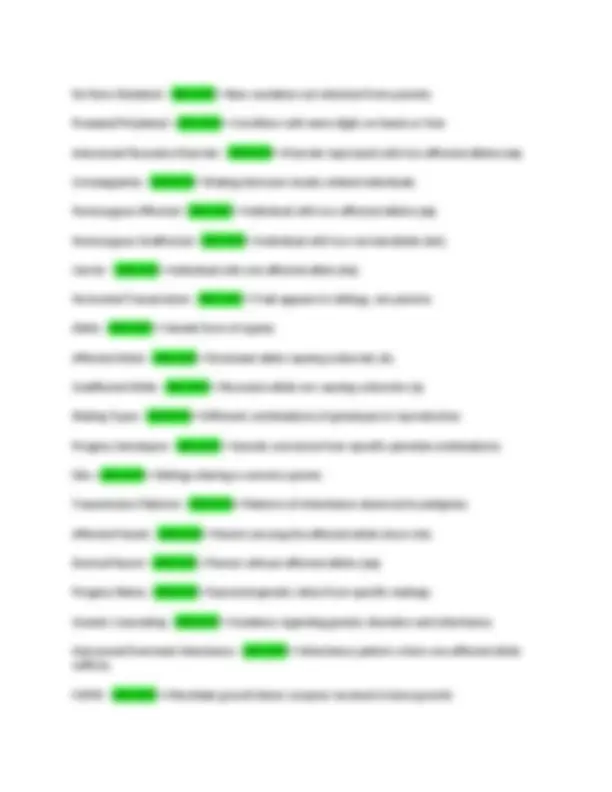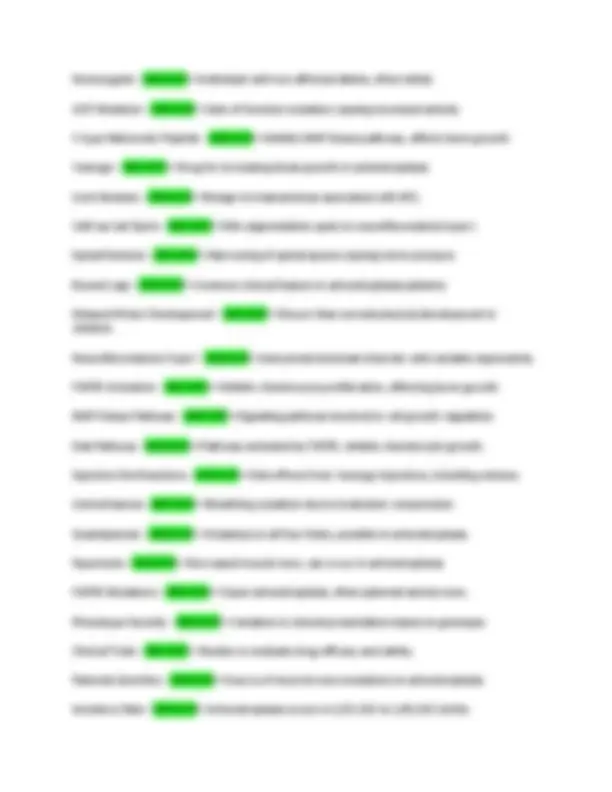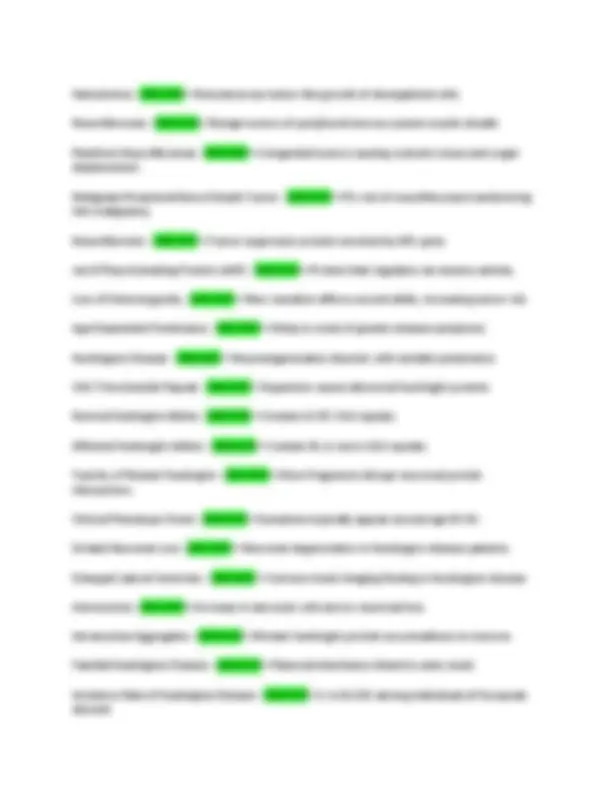





Study with the several resources on Docsity

Earn points by helping other students or get them with a premium plan


Prepare for your exams
Study with the several resources on Docsity

Earn points to download
Earn points by helping other students or get them with a premium plan
Community
Ask the community for help and clear up your study doubts
Discover the best universities in your country according to Docsity users
Free resources
Download our free guides on studying techniques, anxiety management strategies, and thesis advice from Docsity tutors
Autosomal Dominant and Recessive Inheritance Patterns questions and answers.
Typology: Exams
1 / 7

This page cannot be seen from the preview
Don't miss anything!




Autosomal Dominant - ANSWER>>Phenotype is expressed both in homozygotes and heterozygotes regardless of whether normal protein product is made. Autosomal Recessive - ANSWER>>Phenotype expressed only in homozygotes. Pleiotropy - ANSWER>>A disorder due to a single affected gene or gene pairs that affect multiple organs and result in multiple phenotypes. Penetrance - ANSWER>>Percentage of people with a genotype that display a clinical phenotype. Expressivity - ANSWER>>Severity of expression of phenotype among individuals with the same disease-causing genotype. Co-dominant - ANSWER>>Phenotype results from expression of two different allele loci (ex. ABO blood types). Incomplete Dominance - ANSWER>>Phenotype of a dominant disorder is more severe in homozygotes vs. heterozygotes. Genotype - ANSWER>>Sequence of DNA at all or any loci. Phenotype - ANSWER>>What is seen visually, laboratory results, radiology results, etc. Haplotype - ANSWER>>Set of alleles at a locus or cluster of loci; a group of genes that are inherited together from a single parent. Proband - ANSWER>>The individual being studied or reported on in a pedigree. 3 - generation pedigree - ANSWER>>A diagram that shows the relationships between family members across three generations. Circle (in pedigrees) - ANSWER>>Represents females. Square (in pedigrees) - ANSWER>>Represents males. Diamond (in pedigrees) - ANSWER>>Represents unspecified sex.
Horizontal line (in pedigrees) - ANSWER>>Represents mating between male and female. Vertical line (in pedigrees) - ANSWER>>Indicates offspring from mating. Roman numbers (in pedigrees) - ANSWER>>Indicate generations. Birth order numbers (in pedigrees) - ANSWER>>Numbers such as 1, 2, and 3 indicate birth order of siblings. Identical twins (in pedigrees) - ANSWER>>Joined by a horizontal line. Fraternal twins (in pedigrees) - ANSWER>>No horizontal line indicates fraternal twins. Recurrence risk - ANSWER>>The probability of a genetic disorder occurring in future progeny based on pedigree analysis. Achondroplasia - ANSWER>>A genetic disorder characterized by dwarfism due to a mutation in the FGFR3 gene. Huntington disease - ANSWER>>A genetic disorder that causes the progressive breakdown of nerve cells in the brain. Tay Sachs - ANSWER>>A genetic disorder that results in the destruction of nerve cells in the brain and spinal cord. Cystic fibrosis - ANSWER>>A genetic disorder that affects the lungs and digestive system due to a mutation in the CFTR gene. Neurofibromatosis I - ANSWER>>A genetic disorder that causes tumors to grow on nerves and skin. Autosomal Dominant Disorder - ANSWER>>Disorder expressed with one affected allele (A). Heterozygote - ANSWER>>Individual with one dominant and one recessive allele (Aa). Affected Progeny - ANSWER>>Offspring exhibiting the disease phenotype. Recurrence Risk - ANSWER>>Probability of offspring inheriting a disorder. Pedigree - ANSWER>>Diagram showing family genetic relationships. Vertical Transmission - ANSWER>>Trait appears in successive generations. Reduced Penetrance - ANSWER>>Not all individuals with genotype express phenotype.
Homozygote - ANSWER>>Individual with two affected alleles, often lethal. GOF Mutation - ANSWER>>Gain of function mutation causing increased activity. C-type Natriuretic Peptide - ANSWER>>Inhibits MAP kinase pathway, affects bone growth. Voxzogo - ANSWER>>Drug for increasing linear growth in achondroplasia. Lisch Nodules - ANSWER>>Benign iris hamartomas associated with NF1. Café au Lait Spots - ANSWER>>Skin pigmentation spots in neurofibromatosis type I. Spinal Stenosis - ANSWER>>Narrowing of spinal spaces causing nerve pressure. Bowed Legs - ANSWER>>Common clinical feature in achondroplasia patients. Delayed Motor Development - ANSWER>>Slower than normal physical development in children. Neurofibromatosis Type I - ANSWER>>Autosomal dominant disorder with variable expressivity. FGFR3 Activation - ANSWER>>Inhibits chondrocyte proliferation, affecting bone growth. MAP Kinase Pathway - ANSWER>>Signaling pathway involved in cell growth regulation. Stat Pathway - ANSWER>>Pathway activated by FGFR3, inhibits chondrocyte growth. Injection Site Reactions - ANSWER>>Side effects from Voxzogo injections, including redness. Central Apnea - ANSWER>>Breathing cessation due to brainstem compression. Quadriparesis - ANSWER>>Weakness in all four limbs, possible in achondroplasia. Hypotonia - ANSWER>>Decreased muscle tone, can occur in achondroplasia. FGFR3 Mutations - ANSWER>>Cause achondroplasia, often paternal and de novo. Phenotype Severity - ANSWER>>Variation in clinical presentation based on genotype. Clinical Trials - ANSWER>>Studies to evaluate drug efficacy and safety. Paternal Germline - ANSWER>>Source of most de novo mutations in achondroplasia. Incidence Rate - ANSWER>>Achondroplasia occurs in 1/15,000 to 1/40,000 births.
Hamartoma - ANSWER>>Noncancerous tumor-like growth of disorganized cells. Neurofibromas - ANSWER>>Benign tumors of peripheral nervous system myelin sheath. Plexiform Neurofibromas - ANSWER>>Congenital tumors causing cosmetic issues and organ displacement. Malignant Peripheral Nerve Sheath Tumor - ANSWER>>5% risk of neurofibromas transforming into malignancy. Neurofibromin - ANSWER>>Tumor suppressor protein encoded by NF1 gene. ras GTPase Activating Protein (GAP) - ANSWER>>Protein that regulates ras enzyme activity. Loss of Heterozygosity - ANSWER>>New mutation affects second allele, increasing tumor risk. Age-Dependent Penetrance - ANSWER>>Delay in onset of genetic disease symptoms. Huntington Disease - ANSWER>>Neurodegenerative disorder with variable penetrance. CAG Trinucleotide Repeat - ANSWER>>Expansion causes abnormal huntingtin protein. Normal Huntingtin Alleles - ANSWER>>Contain 10-35 CAG repeats. Affected Huntingtin Alleles - ANSWER>>Contain 36 or more CAG repeats. Toxicity of Mutant Huntingtin - ANSWER>>Short fragments disrupt neuronal protein interactions. Clinical Phenotype Onset - ANSWER>>Symptoms typically appear around age 30-50. Striatal Neuronal Loss - ANSWER>>Neuronal degeneration in Huntington disease patients. Enlarged Lateral Ventricles - ANSWER>>Common brain imaging finding in Huntington disease. Astrocytosis - ANSWER>>Increase in astrocyte cells due to neuronal loss. Intranuclear Aggregates - ANSWER>>Mutant huntingtin protein accumulations in neurons. Familial Huntington Disease - ANSWER>>Paternal inheritance linked to early onset. Incidence Rate of Huntington Disease - ANSWER>>1 in 20,000 among individuals of European descent.
Juvenile Tay-Sachs - ANSWER>>Onset between 2-6 years, includes ataxia and blindness. Adult Tay-Sachs - ANSWER>>Onset after 10 years, includes spinocerebellar ataxia. Substrate Reduction Therapy - ANSWER>>Experimental treatment for Tay-Sachs, no measurable benefit. Dor Yeshorim - ANSWER>>Genetic testing for arranged marriages in Jewish communities. Clinical Phenotype - ANSWER>>Observable characteristics resulting from genetic disorders. Variable Expressivity - ANSWER>>Different manifestations of the same genetic disorder. Immunoreactive Trypsin - ANSWER>>Elevated levels indicate possible cystic fibrosis. Neurological Degenerative Disorder - ANSWER>>Progressive loss of neuron function and structure.